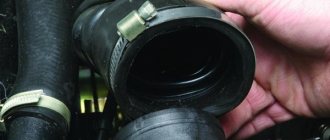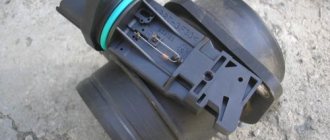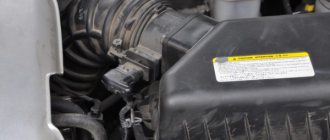02/04/2022 34 156 Sensors
Author: Ivan Baranov
The Bosch 116 mass air flow sensor or mass air flow sensor is a regulator designed to control the volume of air that enters the engine. This controller is one of the elements of electronic engine control systems with fuel injection. In this article we will try to answer the question of how models 116 and 037 differ.
[Hide]
Differences between mass air flow sensors
Welcome to ChipTuner Forum.
Theme Options
maxail
In issue No. 3 of 2006, the magazine “behind the wheel” wrote:
» The third version of the mass air flow sensor is 037. (Here we are talking about the last three digits in the designation.) This is a further development of the 004th sensor from Bosch. Such a sensor is used today on most VAZ cars driving on the roads, including Niva and Chevrolet Niva. Externally, 004 and 037 are almost indistinguishable - just look at the number (photo 3). Recently, additional markings have appeared on products: now there are numbers on both the body and the measuring element - they must match. The main difference is inside the mass air flow sensor. In photo 4 on the right is the 037th sensor. It has a different design of the measuring element, with a characteristic cutout (when purchasing, it makes sense to remove the plug and look inside).
But now a new control system has appeared - Bosch-M7.9.7, which has its own, 116th, mass air flow sensor. It is not interchangeable with the previous ones, although its body is the same. To avoid confusion, a green circle was initially applied to the body (photo 5). There are numbers on both the body and the measuring element (photo 6). The latter determines the purpose of this mass air flow sensor - the design has been changed again (photo 7). To prevent elements from being replaced on the way from the factory to the consumer, the kind German designers installed other secret screws. Eh, naive! The required tool is already sold on the Russian market. Carefully inspect the mass air flow sensor: when unscrewing the secret screws, their coating is usually damaged. If you notice, draw your own conclusions!”
Source
Mass air flow sensor table. VAZ DMRV engines. Last three digits
But to implement them, it is necessary that the sensors informing the controller do not deceive it - only under this condition do the processes in the cylinders proceed normally, the engine develops sufficient power without consuming excess fuel and without causing much harm to the environment. One of these sensors measures the amount of air entering the cylinders and generates a corresponding signal to the controller. This can be an absolute pressure sensor (MAP sensor) or a mass air flow sensor (MAF). We see the latter on many cars, including VAZ ones.
The first was the frequency mass air flow sensor of the GM control system. It was also used in the domestic analogue “January” of the 4th series (photo 1). Cars of this configuration did not last long on the assembly line - the frequency sensor was replaced by an analog model HFM-5 from Bosch - its number is 0280218004 (photo 2). It is not interchangeable with GM - the connectors and mounting points are different. The German sensor is dismountable, consisting of two parts - a housing and a measuring element.
The latter is secured in the case with two screws with “secret” heads. True, nowadays you can buy the necessary tools in auto parts stores. The measuring element is a compact thing, but it is expensive - in Moscow from 1300 rubles. and higher. Having removed this part from a new car, in exchange, of course, they will put a dummy, and everything that follows is the “personal grief” of the car buyer. The market is full of such “mass air flow sensors without a housing”... It is unwise to buy a measuring element without a housing: it is very possible that it is faulty or the wrong model. Bosch only sells assembled sensors in traditional yellow cardboard packaging. Let us remind you that the store may not accept a return air flow sensor purchased from the “wrong system” if the motorist does not provide a certificate from the service, and it is often difficult to obtain one. An unnecessary expensive unit will remain as a keepsake.
The third version of the mass air flow sensor is 037. (Here we are talking about the last three digits in the designation.) This is a further development of the 004th sensor from Bosch. Such a sensor is used today on most VAZ cars traveling on the roads, including Niva and Chevrolet Niva. Externally, 004 and 037 are almost indistinguishable - just look at the number (photo 3). Recently, additional markings have appeared on products: now there are numbers on both the body and the measuring element - they must match. The main difference is inside the mass air flow sensor. In photo 4 on the right is the 037th sensor. It has a different design of the measuring element, with a characteristic cutout (when purchasing, it makes sense to remove the plug and look inside).
Purchasing a new and replacing the mass air flow sensor
Purchasing and replacing a mass air flow sensor is not a problem. The market is teeming with offers. Prices also vary from 2500 to 9000 rubles. For VAZ and GAZ, look for Bosch products with article number 0280218037.
To replace you will need:
- Cross-shaped or flat decoction.
- Key head 10 (for Lada Kalina).
Procedure:
- Loosen the air duct clamp bolt and move the latter to the side.
- Press the button under the plug and pull the latter out of the connector.
- Using a 10mm wrench, unscrew the two bolts (one on top, the other on bottom).
- Remove the sensor.
- Installation in reverse order.
1 of 3
— +
1.
2.
3.
Before buying a new flow meter, pay attention to the markings of the old one. It is advisable to purchase a product with the same marking so that it is guaranteed to be compatible with the car’s ECU.
The main thing after replacement is not to forget to adapt the new flow meter. To do this, remove the negative terminal of the battery for a few minutes to expose the data in the ECU.
In some car models, this cannot be done in a garage; you will have to go to a service center where there is special diagnostic equipment.
VAZ air flow sensor pinout. Checking and repairing the air flow sensor
Based on the signal from the mass air flow sensor (MAF), the cyclic filling of the cylinder is calculated, which is ultimately converted into the duration of the injector opening pulse. If it does not work correctly, the car consumes more gasoline than necessary. Such a sensor is installed on the second path, immediately behind the air filter and connected to the electrical system, which is controlled by a six-pin block of wires.
There are quite a few different types of mass air flow sensors: mechanical, ultrasonic, hot-wire and some others.
In this case, we will consider the design of the HFM-5 hot-wire sensor from Bosch, which is most often installed on VAZ cars. The sensor's sensitive element is a thin film on which several temperature sensors and a heating resistor are located. In the middle of the film there is a heating area, the degree of heating of which is controlled using a temperature sensor.
On the surface of the film, on the side of the air flow and on the opposite side, two more thermal sensors are located symmetrically, which record the same temperature in the absence of air flow. In the presence of air flow, the first sensor is cooled, and the temperature of the second remains unchanged, due to the heating of the air flow in the heater zone. The differential signal of both sensors is proportional to the mass of passing air.
- 1 – dielectric diaphragm
- H – heating resistor
- SH – Load temperature sensor. resistor
- SL – Air temperature sensor
- S1 and S2 – temperature sensors before and after the heater.
- QLM – air flow mass
- t – temperature
The sensor's electronic circuit converts this signal into a constant voltage proportional to the air mass. This design is called Hot Film (HFM), its advantages include high measurement accuracy and the ability to record reverse air flow, but its disadvantages include low reliability in conditions of contamination and moisture.
To measure the amount of air that enters the engine means to determine the engine load. When the driver presses the gas pedal, the throttle valve opens and the amount of intake air increases. At the same time, we say that the load has increased. When you release the pedal, the load drops. It's quite simple. However, this is only at first glance. If we take into account the fact that in real driving conditions the engine often changes operating modes and the incoming air in the intake system participates in several gas-dynamic processes, then the problem of measuring the air in the system is not so simple.
In older systems (ECU January-4 and GM-ISFI-2S), other hot-wire mass flow sensors were used, the sensitive elements of which were made in the form of threads. Such sensors are called Hot Wire MAF Sensor. The output signal of these sensors was frequency, that is, depending on the air flow, it was not the voltage that changed, but the frequency of the output pulses. The sensors were less accurate and did not allow registering reverse flow, but these shortcomings were offset by very high reliability.
Causes of failure
Here we list the main reasons why the mass air flow sensor fails or does not work correctly:
- Burnout (burst) of the thermistor or damage to the coating on the tracks. This disease is especially typical for the HFM-5 sensor model. This can happen as a result of natural wear and tear or a sudden surge in voltage in the network (the generator has failed, etc.). On average, wire devices last about 150 thousand car miles.
- Lack of voltage – break in the signal or operating electrical circuit, the sensor is not connected, oxidation of the contacts.
- The ECU has failed.
- Incorrect maintenance. The flow meter is considered a maintenance-free device and can be replaced as an assembly. But since it is expensive, many try to clean it, for example, with cotton wool, which is wrong. To do this, use compressed air or special liquids (carbocleaner, special air flow sensor cleaner or other alcohol-based product).
Indirect reasons:
- The throttle valve is jammed as a result of its contamination - in this case, the sensor seems to be working, but the information is not transmitted to the ECU correctly.
- The air filter is clogged.
VAZ 2110 air sensor pinout diagram
- Yellow (closest to the windshield) - mass air flow sensor signal input;
- Gray-white—sensor supply voltage output;
- Green — sensor grounding output;
- Pink-black - to the main relay.
The wire colors may change, but the pin locations remain the same.
Let’s also add that the mass air flow sensor with endings 004, 037, 116 (for Bosch) and 00, 10, 20 (for Pekar) are different in calibration. You can only change it by flashing it.
Connecting the MAF air sensor VAZ 2112
If the mass air flow sensor is operational, then when the engine is running at 900 rpm, the volume of air used will be at least 10 kg per hour. When the speed increases to 2 thousand, this figure will increase to approximately 20 kg. If the volume of air at such speeds drops, the dynamics of the vehicle will also decrease, and accordingly, this will lead to a decrease in gasoline consumption.
If these indicators increase, this will also contribute to an increase in fuel volume. Deviations of the parameter by 2-3 kg should not be allowed, since in this case the operation of the power unit may be incorrect.
Recommendations for increasing service life
To extend the life of the MAF sensor, follow these recommendations:
- Change the air filter promptly to minimize clogging of the flow meter.
- Monitor the technical condition of the engine, carry out maintenance on time, change and fill only with high-quality engine oil.
- If the car has a high mileage, check the engine compression - wear or jamming of the piston rings and valve seals will lead to oil penetration into the intake system. This will prevent the appearance of oil deposits on the thermistors.
- Monitor the condition of the crankcase ventilation system. This is especially true for those engines where the crankcase gas suction pipe is connected in front of the mass air flow sensor. Check the condition of the oil separator under the valve cover.
Connection diagram for air flow sensor 2114
A common cause of incorrect operation of the mass air flow sensor is the failure of electronic components, which increases the sensor’s response time to changes in air flow. A working sensor monitors changes at a speed of 0.5 ms, and if it breaks down, the response time increases by 20-30 times. The defect is detected only by recording the operation graph with an oscilloscope. Such a sensor cannot be repaired; it must be replaced with a new one.
How to check the mass air flow sensor with a multimeter
Self-diagnosis will not only allow you to avoid sudden problems, but will also indicate the timing of a possible replacement of the flow meter. The object of measurement is contact No. 5 on the connector. The quiescent voltage is measured relative to the negative contact No. 3.
We turn off the engine, turn the ignition key to the “ON” position, but do not turn the starter. We connect the measuring leads to the mass flow sensor connector.
- good condition: voltage within 0.98 V - 1.02 V;
- there is wear, but it is not critical: 1.03 V - 1.04 V;
- critical wear, replacement soon: 1.05 V;
- voltage more than 1.05 V – sensor is faulty.
Checking the air sensor yourself
When a malfunction of the mass air flow sensor occurs, the air-fuel mixture becomes over-rich or lean, which immediately affects the operation of the engine and may ultimately result in engine failure.
Symptoms of a malfunctioning mass air flow sensor:
- Check Engine error appears;
- Increased fuel consumption;
- Doesn't start well when hot;
- The car began to accelerate slowly;
- Engine power lost.
The easiest way to check the mass air flow sensor on a VAZ 2114 is to disconnect the plug. If there is no signal, the engine control unit goes into emergency operation mode, determining the approximate air volume based on the throttle position. At the same time, fuel consumption increases slightly - for the VAZ 2114 it reaches 10-12 liters per 100 km. A characteristic feature is the increase in idle speed to 1500 rpm. But when using a January 7.2 or Bosch M7.9.7 controller, the idle speed does not increase due to the software features.
Replacing the sensor - instructions
Using a screwdriver, unscrew the clamp of the air intake corrugation at the sensor outlet, pull it off and carefully inspect the internal surfaces of the sensor itself and the corrugation. These surfaces must be dry and clean; traces of condensation and oil are unacceptable. If the air filter is changed rarely, then dirt getting on the sensitive element of the sensor is the most common cause of its breakdown in VAZ cars.
There may be oil in the mass air flow sensor as a result of an increased oil level in the engine crankcase, or the oil sump of the crankcase ventilation system is clogged.
Next, unscrew the 2 screws of the sensor with a 10mm wrench and remove it from the air filter housing. There should be a rubber sealing ring on its front part (at the entrance edge). It prevents unfiltered air from being sucked into the intake tract through the sensor.
If the ring is out of place and stuck somewhere in the air filter housing, then there will be a thin layer of dust on the inlet mesh of the sensor itself. This is the second reason that destroys the mass air flow sensor ahead of time.
Correct assembly should take place in the following sequence: put a sealing rubber band on the sensor, check the sealing skirt, then insert everything together into the filter housing.
This concludes the visual check of the mass air flow sensor at home. You can check its operation 100% only with the help of special equipment in a car service center. For example, using a technique for assessing the oscillogram when the throttle is sharply opened to the cutoff mode (a motor tester is needed), or assessing the oscillogram when the ignition is turned on.
Resuscitation of a damaged air flow sensor is successful in no more than 5% of cases. In extreme cases, you can rinse with ethereal liquid to clean matrices and optics. It will evaporate without a trace. After making sure that there is no more dust or debris in the device, you can dry it thoroughly and put it back in place. Sometimes after such a simple procedure the device will work.
On most foreign cars, a mass air flow sensor was installed until 2000; subsequent generations of models began to be equipped with a pressure controller. Replacing a non-working sensor is simple and can be done on your own without any problems, you just need to buy a mass air flow sensor that matches the ECU firmware version. Its price is around 3,000 rubles, depending on the manufacturer.
Source
Features of testing for Ford Focus 2
In most cases, for foreign cars, the flow meter diagnostic methods are similar, but they still have their own characteristics. It all depends on the car model and the brand of the installed MAF sensor.
For example, on Ford Focus 2 there are sensors with four or six wires. Original product FORD 1072308.
The pinout is shown below using an example of a 4-wire sensor.
- A – voltage 12V.
- B – “–” (mass).
- C – “–” reverse earth (literal translation).
- D – output signal SIG to the ECU.
Two additional wires are connected to the 6-pin sensors: IAT (intake air temperature) sensors.
To check the mass air flow sensor on a Ford Focus 2, do the following:
- Disconnect the connector from the flow meter.
- Turn on the ignition.
- Connect the “–” of the multimeter to “B” (ground) on the wiring harness (see the figure above).
- “+” of the device to positive “A” (12V).
The multimeter should show 12V. If not, then we look for the reason why the sensor does not receive U.
Next steps (you will need an assistant):
- Plug the chip back in.
- Without turning off the ignition, using sharp multimeter probes, connect “+” (pierce the wire) to the signal “D”, and “–” to “C” (reverse ground). The norm is 0.9 – 1.0V.
- Ask an assistant to start the car, warm it up and set the speed to 1500. The device should show 1.4 - 1.6V. At 2500 rpm – 1.8 – 2.0V.
- With the gas pedal fully depressed (as the speed increases), the device should show from 0.2 to 5V.
The range of standard indicators is not indicated by chance. It will vary depending on engine size.
Also diagnose Ford Focus 2 with a scanner (read above). The standard air flow rate is 9–12 kg/h or about 2.8 g/s at idle speed.











